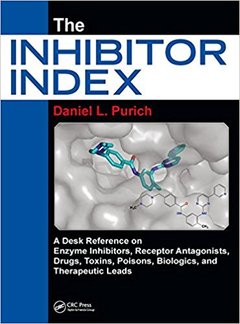Description
The Inhibitor Index
A Desk Reference on Enzyme Inhibitors, Receptor Antagonists, Drugs, Toxins, Poisons, Biologics, and Therapeutic Leads
Author: Purich Daniel
Language: English
Subjects for The Inhibitor Index:
Keywords
Key Pharmacokinetic Parameters; enzyme inhibitor; McGraw Hill Medical; toxin; Protein Kinase; drug discovery; Enzyme Inhib; metabolic inhibitor; Life Sci; Daniel L; Purich; Aldose Reductase; receptor-directed inhibitor; ATP Synthase; signal transduction cascades; Phosphoribosyl Pyrophosphate Synthetase; receptor antagonists; Weakly Inhibited; metabolic uncouplers; Plant Physiol; metabolic inhibitors; Phosphatidate Phosphatase; Acetyl CoA Carboxylase; Agents Chemother; DNA Biosynthesis; DNA Topoisomerase; FAAH; DNA Gyrase; DNA Direct RNA Polymerase; Viral DNA Polymerase; Leucyl Aminopeptidase; M1 RNA; UTI; Urinary Trypsin Inhibitor; GSK J1; UDP Glucose Dehydrogenase
Approximative price 250.90 €
In Print (Delivery period: 14 days).
Add to cart1362 p. · 21x28 cm · Hardback
Description
/li>Contents
/li>Biography
/li>
Metabolic inhibitors and receptor antagonists are indispensable tools for the molecular life scientist. By blocking specific enzymes or receptor-mediated signal transduction cascades, they simplify the analysis of complex cellular processes especially when it is essential to demonstrate that a process of interest is functionally linked to a particular enzyme or receptor. From antibiotics to statins, modern medicine relies on the reliability and ease-of-use of enzyme- and receptor-directed inhibitors and antagonists.The Inhibitor Index is a comprehensive, curated compendium of over 7,800 enzyme inhibitors and receptor antagonists, including many toxins, poisons, and metabolic uncouplers.
No TOC, it is an alphabetical listing of compounds.
Dan Purich earned his Ph.D. for ground-breaking work on brain hexokinase, adenine nucleotide control, and multisubstrate inhibitors under Herbert Fromm at Iowa State University. After investigating the glutamine synthetase adenylylation cascade as an NIH Staff Fellow under Earl Stadtman, he joined the Chemistry Department at UC Santa Barbara. Awarded a Sloan Fellowship in Chemistry and NIH Research Career Development Award, Purich rose to full professor before moving to the University of Florida College of Medicine to become Chair of Biochemistry & Molecular Biology. He served on the Journal of Biological Chemistry,Archives of Biochemistry & Biophysics, and Biophysical Chemistry editorial boards. He also edited the six-volume Enzyme Kinetics &Mechanism sub-series of Methods in Enzymology and wrote The Handbook of Biochemical Kinetics (2000), The Enzyme Reference (2002), and Enzyme Kinetics: Catalysis & Control (2010). Author of over 170 peer-reviewed papers, chapters and reviews on enzyme action and cytoskeleton self-assembly, Purich discovered the actoclampins, the (+)-end-tracking motors that power actin-based motility by harnessing the Gibbs energy of on-filament ATP hydrolysis, while catalyzing monomer insertion. For fun, he travels and writes mystery novels.




